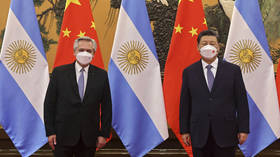China ‘eating US’ lunch’ in Latin America, senator warns
US belatedly realizes that China is cutting lucrative deals in South America

Latin American nations have been distancing themselves from their neighbor to the north and joining China’s Belt and Road Initiative, US senators discussed on Thursday during a Senate Foreign Relations subcommittee hearing.
The senators spoke of the looming threat of Chinese influence in Latin America - a region which was once considered their own backyard but has since been wooed by Beijing’s deep pockets and big infrastructure projects.
“China has a plan. We don’t have a plan,” Sen. Edward Markey (D-Massachusetts) explained, while officials from several US agencies discussed their strategies. These mostly consisted of pointing out flaws with Chinese projects and talking up the US alternatives: supposedly stronger labor, environmental and anti-corruption regulations.
Officials with the State Department, USAID, and International Development Finance Corporation brought up examples of projects in which apparent Chinese corner-cutting had led to negative outcomes - including Coca Codo Sinclair, a Chinese-built and -financed dam in Ecuador that has been plagued by cracks and other mishaps since its opening in 2016 - as an example of “the PRC prioriti[zing] only the prosperity of the PRC, often to the detriment of the prosperity of the local people.” Witnesses cited a huge uptick in illegal fishing by Chinese vessels in Caribbean, Argentinian, Chilean, Peruvian, and Ecuadorian waters.
A survey recently conducted by Vanderbilt University showed regional trust in China declining by 18 percentage points from 2012 to 2021 while trust in the US grew 18 percentage points, leaving China lagging behind with a trust rating of 38% to the US’ 55%. However, with little to compare by way of US-built projects and efforts in the region, countries like Ecuador - or Argentina, which signed on to the Belt and Road Initiative in February - are willing to take quality risks in return for the certainty of Chinese money, experts told the South China Morning Post.
Beijing’s trade with the region has soared by over $300 billion from 2002 to 2020, with $160 billion directly invested during that time. 20 of the 31 Latin American countries have signed on to be part of the Belt and Road, China has financed infrastructure projects in another five nations, and several countries have been persuaded to drop diplomatic relations with Taiwan - a clear sign of increasing closeness to Beijing.
The US, meanwhile, is struggling to even fill regional ambassador spots in Latin America, with political disagreements tying up eight appointments, and four languishing without even a nominee suggested to fill them. The country’s attention is clearly directed elsewhere, as even existing programs for regional investment are underfunded, witnesses said. Sen. Bill Hagerty (R-Tennessee) lamented that China was “literally eating our lunch” in the hemisphere once considered the US’ default sphere of influence under the Monroe Doctrine - and all that with only 9% of Belt and Road spending being devoted to Latin America and the Caribbean as of last year.
For its part, China does not appear to be threatened by its rival’s realization that it has competition, pointing out that Washington has long taken Latin America’s allegiance for granted. “The United States has regarded Latin America and the Caribbean as its own ‘backyard’, and has been putting pressure and threats at every turn,” Chinese US embassy spokesman Liu Pengyu told the SCMP. “Who is a real friend, who is a fake friend, who ignores the rules and spreads chaos.”
“I believe the relevant country will make a correct judgment,” he said.
https://www.rt.com/news/553187-latin-america-prefers-china-investments/


0 Comments:
Post a Comment
Subscribe to Post Comments [Atom]
<< Home